
The pearl-spotted owlet is a small bird of prey found in sub-Saharan Africa. They belong to the Strigidae family, otherwise known as the typical owls or the true owls, which contains most species of owl. As part of the genus Glaucidium, or pygmy owls, they are commonly referred to as 'owlets' due to their diminutive size. Pearl-spotted owlets are brownish and heavily spotted white, with two distinct black false 'eyes' at the back of their head. They are often confused with an African barred owlet.
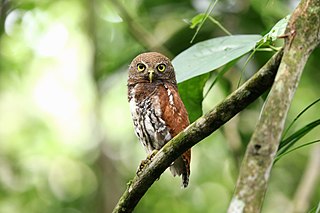
The chestnut-backed owlet, is an owl which is endemic to Sri Lanka. This species is a part of the larger grouping of owls known as typical owls, Strigidae, which contains most of the smaller owl species. This species was formerly considered to be a subspecies of the jungle owlet.

The ferruginous pygmy owl is a small owl that breeds in south-central Arizona and southern Texas in the United States, south through Mexico and Central America, to South America into Brazil, Bolivia, Paraguay and Argentina.

The jungle owlet or barred jungle owlet is native to the Indian Subcontinent. The species is often found singly, in pairs or small groups, and they are usually detected by their calls at dawn and dusk. There are two subspecies, with that found in the Western Ghats sometimes considered a full species.
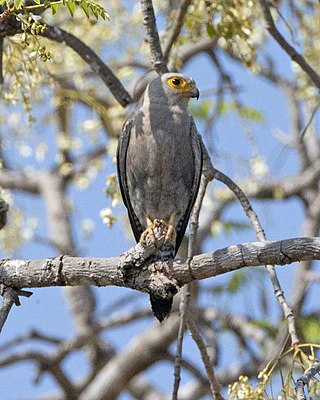
Dickinson's kestrel is a bird of prey of southern and eastern Africa belonging to the falcon family Falconidae. It is named after John Dickinson, an English physician and missionary who collected the type specimen. It is also known as the white-rumped kestrel. Its closest relatives are the grey kestrel and banded kestrel and the three are sometimes placed in the subgenus Dissodectes.

The eastern (pale) chanting goshawk, or Somali chanting goshawk, is a bird of prey of East Africa.

The augur buzzard is a fairly large African bird of prey. This species is distinct in typical adult plumage for its blackish back, whitish underside and orange-red tail, while juvenile augur buzzards are generally rather brown in colour; however a dark morph is known, which causes the bird's entire body to become darker. This member of the Buteo genus is distributed in several parts of the central and southern Africa, normally being found from Ethiopia to southern Angola and central Namibia. It is resident and non-migratory throughout its range. This is a species of mountains, and adjacent savannah and grassland. This is a typical buteonine raptor, being a generalist predator which tends to prefer small mammals supplemented by reptiles and birds among various prey items.

The mountain buzzard is a bird of prey that lives in montane forests in East Africa, it and the forest buzzard of southern Africa were, until recently, considered to be a single species.

The African wood owl or Woodford's owl, is a typical owl from the genus Strix in the family Strigidae which is widespread in sub-Saharan Africa.

The rufous-naped lark or rufous-naped bush lark is a widespread and conspicuous species of lark in the lightly wooded grasslands, open savannas and farmlands of the Afrotropics. Males attract attention to themselves by a bold and often repeated wing-fluttering display from a prominent perch, which is accompanied by a melodious and far-carrying whistled phrase. This rudimentary display has been proposed as the precursor to the wing-clapping displays of other bush lark species. They have consistently rufous outer wings and a short erectile crest, but the remaining plumage hues and markings are individually and geographically variable. It has a straight lower, and longish, curved upper mandible.
The Albertine owlet or Prigogine's owlet is a small species of small owl in the family Strigidae, native to the Albertine Rift montane forests.
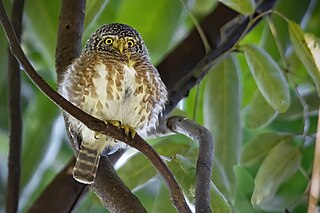
The collared owlet, also known as the collared pygmy owl, is a species of owl in the family Strigidae. Its natural habitat is submontane and montane forests with open spaces and is distributed throughout oriental Asia. It is the smallest owl in Asia, at 15 cm (5.9 in) and 60 g (2.1 oz).
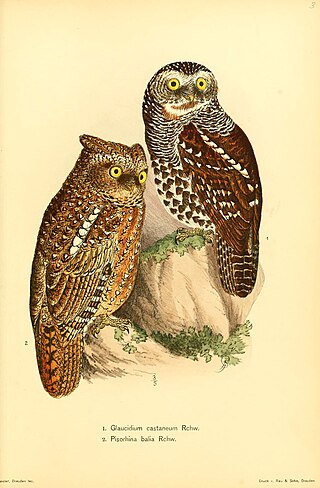
The chestnut owlet is a subspecies of owl to the African barred owlet in the family Strigidae. It is found in west and central Africa in two allopatric subspecies that possibly could be classified as separate species.
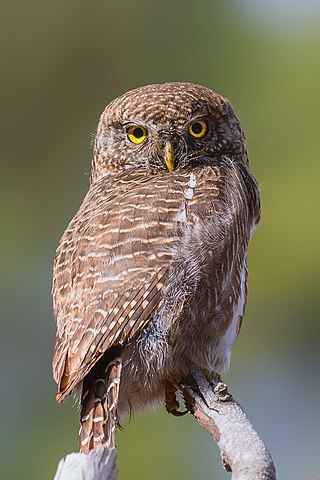
The Asian Barred Owlet also known as the Cuckoo owlet is a species of pygmy owl native to the forests and shrublands of mainland Southeast Asia to the foothills of the Himalayas of northern Pakistan. It is a smaller owl, measuring 22–25 cm (8.7–9.8 in) making it one of the larger pygmy owls. They are primarily insectivorous but will eat lizards, small rodents and birds as well.
Sjöstedt's barred owlet, also known as Sjöstedt's owlet, is a species of owl in the family Strigidae from west central Africa.

The red-chested owlet is a species of owl in the family Strigidae, native to the African tropical rainforest. Its habits and behaviour are poorly known.

The white-browed owl, also known as the white-browed hawk-owl or the Madagascar hawk-owl, is a species of owl in the family Strigidae. It is endemic to Madagascar.

The African grass owl is a species of owl in the barn owl family, Tytonidae.

The ashy flycatcher is a species of bird in the Old World flycatcher family Muscicapidae. It is found throughout sub-Saharan Africa, excluding the drier areas of South Africa, Botswana, and Namibia, where it inhabits subtropical or tropical dry forest, subtropical or tropical moist lowland forest, and savanna. It has a disputed generic placement, with different authorities variously putting it in Muscicapa, Fraseria, or other genera. Ashy flycatchers are mostly grey in colour, with pale grey or white underparts, and display no sexual dimorphism.

The little spotted woodpecker or green-backed woodpecker, is a species of bird in the family Picidae. It is native to large parts of tropical central Africa. It has an extensive range and is an uncommon species, and the International Union for Conservation of Nature has rated its conservation status as being of "least concern".



















